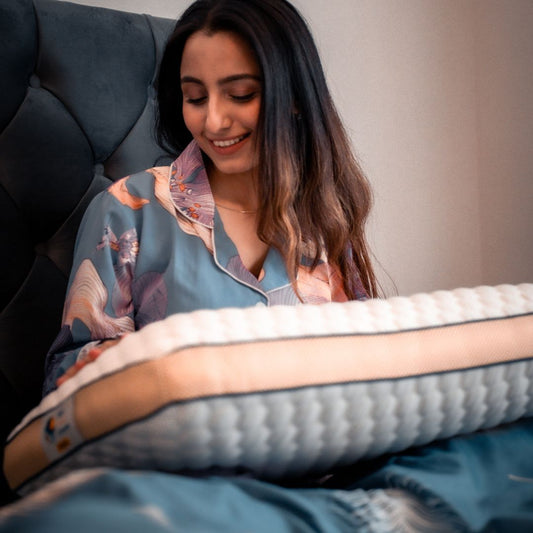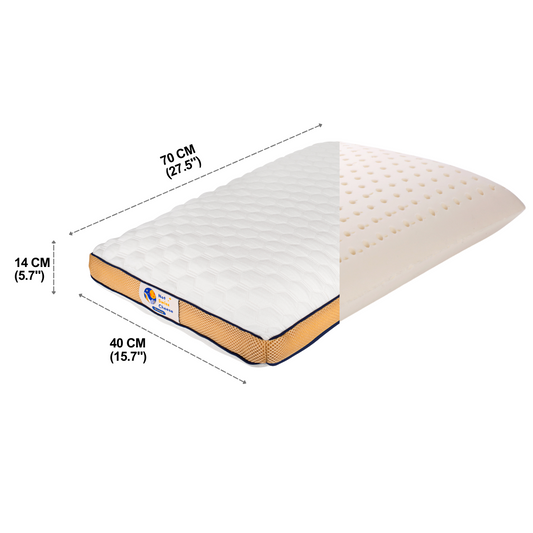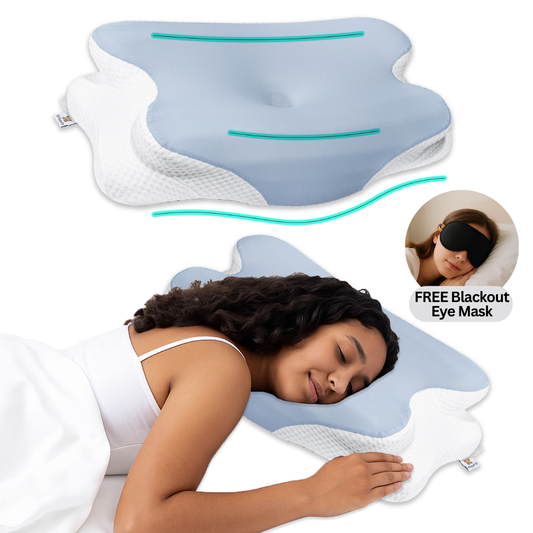As we age, quality sleep becomes essential for maintaining physical, mental, and emotional health. Here's what you need to know:
- Optimal Sleep Duration: Aim for 7–9 hours of sleep each night. Less than 6 hours increases risks of high blood pressure, heart disease, and stroke, while more than 10 hours can also harm health.
- Common Sleep Issues in Older Adults: Sleep becomes lighter, waking up during the night increases, and health conditions like nighttime urination and sleep apnea disrupt rest.
- Brain Health Connection: Restorative sleep clears toxic proteins in the brain, potentially reducing dementia risks.
- Natural Latex Pillows: Supportive bedding, like natural latex pillows, can improve sleep quality. These pillows provide proper alignment, regulate temperature, and are hypoallergenic.
- Better Sleep Habits: Maintain a consistent sleep schedule, optimize your bedroom (cool, dark, and quiet), and address health concerns like insomnia or medication side effects.
Quick Tips for Better Sleep:
- Stick to a regular bedtime and wake-up time.
- Use supportive bedding like latex pillows.
- Keep your bedroom cool (60–68°F), dark, and quiet.
- Avoid caffeine and heavy meals before bed.
- Address sleep-disrupting health issues with your doctor.
By prioritizing quality sleep, you can support healthier aging and reduce risks of chronic conditions.
Latex vs Memory Foam Pillows - Which Is Right For You?
Sleep Changes as You Age
As people age, their sleep patterns and quality undergo noticeable changes. While the recommended 7–9 hours of sleep per night remains consistent, the structure and depth of sleep often shift.
Sleep Problems in Older Adults
Sleep challenges become more common with age, accompanied by distinct changes in sleep habits:
- Sleep becomes lighter, with less time spent in deep, restorative stages.
- Older adults wake up an average of 3–4 times per night .
- Bedtimes and wake times tend to shift earlier.
- Napping increases, with 25% of older adults taking daytime naps compared to just 8% of younger adults .
Health conditions also play a major role in disrupting sleep. For example, up to 80% of older adults experience nighttime urination, which interrupts their rest . Additionally, sleep-disordered breathing affects 30–60% of older individuals .
How Poor Sleep Affects Aging
Poor sleep in older adults can lead to serious health risks. Research has linked inadequate sleep to a higher likelihood of developing various medical conditions:
| Sleep Duration | Associated Health Risks |
|---|---|
| Less than 6 hours | - 23% higher risk of hypertension - 48% higher risk of coronary heart disease - 15% higher risk of stroke |
| More than 10 hours | - 77% higher risk of cardiovascular-related mortality in older women |
For individuals with dementia, restorative sleep is especially important. Dr. Jade Murray, a Postdoctoral Research Fellow at Monash University's School of Psychological Sciences, explains:
"Ensuring we have a restorative sleep helps prevent that [buildup of toxic proteins in the brain]" .
Several factors contribute to these age-related sleep disruptions:
- Hormonal shifts, such as reduced melatonin production and changes in cortisol levels .
- Nearly 40% of adults over 65 take five or more medications that can interfere with sleep .
- Lifestyle changes, like retirement and decreased social engagement, which can affect sleep routines .
Recognizing these challenges is crucial for developing better sleep habits and exploring solutions like supportive bedding to improve sleep quality. These insights pave the way for adopting strategies and products designed to promote healthier sleep.
Natural Latex Pillows and Sleep Quality
As we get older, having the right sleep support becomes more important. Natural latex pillows stand out for their comfort and ability to provide proper support. This ties directly to the benefits they bring, which we’ll explore further.
Why Choose Natural Latex Pillows
Natural latex pillows provide excellent support and comfort, particularly beneficial as we age. Dr. Seema Bonney, Mattress Firm's sleep expert, highlights:
"Natural latex is organic (a natural type of foam derived from the rubber tree's sap), hypoallergenic and antimicrobial, [as it] keeps away pollen, molds, allergens, mildew, and dust mites" .
Here’s why they’re worth considering:
-
Support and Alignment
Latex pillows adapt to your head and neck without sinking too much. Dr. Bonney explains that this ensures proper alignment and helps reduce neck pain . -
Temperature Control
Unlike memory foam, latex pillows disperse heat effectively, keeping you cool throughout the night . This feature is especially helpful for maintaining quality sleep. -
Durability
While most pillows need replacing every one to two years, latex pillows can last up to three years while keeping their shape and support .
Choosing the right type of latex pillow can enhance these benefits even further.
Dunlop vs. Talalay Latex: Key Differences
The choice between Dunlop and Talalay latex depends on your sleep style and support needs. Here’s a comparison to help you decide:
| Feature | Dunlop Latex | Talalay Latex |
|---|---|---|
| Firmness Level | Medium-firm to firm | Soft to medium-soft |
| Support Type | Dense, consistent support | Plush, conforming support |
| Best For | Back and stomach sleepers | Side sleepers, pressure relief |
| Temperature | Good cooling properties | Excellent breathability |
| Durability | Very durable | Durable but slightly less dense |
| Price Point | More affordable | Higher price |
| Ideal Users | Those needing firm support | Side sleepers and hot sleepers seeking softness |
Elina Winnel, a sleep coach from The Sleep Expert, adds that the responsiveness of latex pillows ensures proper alignment for the head and neck, which can ease neck pain . Choosing the right type of latex pillow plays a key role in achieving restorative sleep, which is essential as we age.
For instance, the Saatva Latex Pillow offers great head and neck support, though it may feel firm at first .
sbb-itb-7fb8e9c
How to Select and Use Latex Pillows
Choosing the right latex pillow and taking care of it properly can help you enjoy better sleep, which is essential for your overall well-being.
What to Look for When Buying
When shopping for a latex pillow, certifications and quality are important. Look for GOLS (Global Organic Latex Standard) and Oeko-Tex Standard 100 certifications to ensure you're getting a reliable product .
Here are some key features to consider:
- Material Composition: Make sure the pillow is made from 100% natural latex. Some brands might only include a small amount of latex in their products .
- Cover Material: Opt for a cover made from organic cotton or a natural viscose blend to help regulate moisture.
- Breathability: Check for ventilation channels that allow for better airflow.
- Support Level: Choose firmness based on your needs. For example, Not Swiss Cheese offers a Dunlop option ($54.99) for firmer support and a Talalay option ($74.99) for a softer feel.
Once you’ve identified these features, pick a pillow height that suits your sleeping style.
Correct Pillow Position by Sleep Style
Your sleep position plays a big role in determining the best pillow height and placement for proper spinal alignment. Here’s a quick guide:
| Sleep Position | Pillow Height | Positioning Guide | Recommended Latex Type |
|---|---|---|---|
| Back Sleeper | 3–5 inches | Center your head with ears aligned to shoulders | Medium Dunlop |
| Side Sleeper | 4–6 inches | Keep your nose aligned with your sternum | Talalay |
| Stomach Sleeper | Under 3 inches | Use minimal elevation | Soft Talalay |
To ensure proper alignment, check that your ears line up with your shoulders . You can also try the "towel test" by stacking folded towels and adjusting the height until it feels just right .
Pillow Maintenance and Care
After finding the perfect pillow and positioning it correctly, maintaining it is essential to keep it in good shape.
Basic Care Tips:
- Use a pillow protector under your pillowcase.
- Wash pillowcases weekly and air out your pillow once a month.
- For stains, spot clean with isopropyl alcohol and a clean white cloth .
Cleaning Guidelines:
- Deep Cleaning: Hand wash your pillow once a year using lukewarm water and mild detergent .
- Drying: Gently press the pillow between towels to remove excess water, then air dry it flat, away from direct sunlight .
- Freshening: Sprinkle baking soda on the pillow, let it sit for an hour, and vacuum thoroughly .
Avoid machine washing or drying, as this can damage the material. With proper care, your latex pillow can provide long-lasting comfort and support.
Better Sleep Habits for Aging Well
Good sleep habits play a key role in staying healthy as you age, going beyond just having the right mattress or pillow.
Setting Up Your Bedroom
Creating the right sleep environment can make a big difference. Keep your bedroom cool, dark, and quiet. Studies suggest that a temperature range of 60°F to 68°F is ideal for restful sleep .
Here’s how you can fine-tune your bedroom setup:
| Environmental Factor | Recommended Setting | Product Ideas |
|---|---|---|
| Temperature | 60-68°F | Smart thermostat, cooling mattress pad |
| Humidity | 30-50% | Humidifier or dehumidifier |
| Light | Total darkness | Blackout curtains, sleep mask |
| Sound | Quiet atmosphere | White noise machine, earplugs |
Light control is essential. Blackout curtains can block outside light, helping your body produce melatonin . Using dimmable lights or smart bulbs to gradually reduce brightness before bedtime can also prepare you for sleep.
For noise, a white noise machine can mask disruptions, creating a more peaceful setting. Once your bedroom is optimized, sticking to a consistent sleep schedule will further improve your rest.
Fixed Sleep Schedule Benefits
"Sleep is a rhythm. A good rhythm relies on repetition. Repeating a sleep-friendly routine is critical to sleep success and reaping maximum rewards" .
To establish a sleep schedule:
- Stick to the same bedtime and wake-up time, even on weekends.
- Aim for 7–8 hours of sleep, as recommended by the National Sleep Foundation .
- If changes are needed, adjust gradually - try 15-minute increments.
Studies show that maintaining regular sleep patterns is linked to better overall health . Addressing any health issues that disrupt sleep can further enhance your routine.
Managing Health Issues That Affect Sleep
To maximize the benefits of a good sleep environment and schedule, tackle health concerns that might interfere with rest. Cognitive Behavioral Therapy for Insomnia (CBTI) has been shown to be highly effective, with better results than medication in some studies .
Pain Management
Work with your healthcare provider to manage any pain that might keep you awake.
Medical Considerations
- Review medications with your doctor to identify any that might disrupt sleep .
- Limit fluids 2–3 hours before bed to reduce nighttime trips to the bathroom.
- Address conditions like depression that can impact sleep quality .
Newer sleep aids, such as lemborexant (5 mg), have shown promise with fewer side effects compared to older options . Always consult your doctor before starting any new medication.
Steps to Better Sleep
To improve your sleep, focus on creating the right environment, building healthy habits, and addressing any health concerns. Here's a simple guide to get started:
Set Up Your Bedroom for Sleep
Keep your bedroom cool, dark, and quiet. Use a comfortable mattress and pillows, such as natural latex options, which offer support and help regulate temperature.
Build Healthy Daily Habits
Aim for 7–9 hours of sleep each night . Spend at least two hours outdoors in natural light to support your body's sleep cycle . Stay active, but avoid intense workouts within three hours of bedtime .
Manage Health Issues
For older adults managing multiple prescriptions, review medications with your doctor to ensure they aren't disrupting sleep. If you're dealing with insomnia, Cognitive Behavioral Therapy may be more effective than medication for improving rest .
Refine Your Evening Routine
Incorporate these practices into your nighttime routine to prepare your body for sleep:
- Avoid caffeine at least six hours before bed.
- Skip heavy meals within three hours of sleeping.
- Stick to consistent sleep and wake times.
These steps can make a big difference in your sleep quality and overall well-being.
Related Blog Posts
- "Does improving sleep lead to better mental health
- How sleep effect on emotional health
- Human longevity is associated with regular sleep patterns, maintenance of slow wave sleep, and favorable lipid profile
- Brain Plasticity, Sleep and Aging








